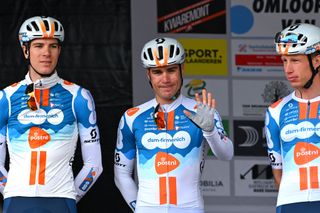A few of professional biking’s most famous gear specialists have independently shunned the concept that proscribing gears will enhance rider security within the professional peloton.
Dan Bigham, previously Efficiency Engineer at Ineos Grenadiers and now Head of Engineering at Crimson Bull Bora-Hansgrohe, and Casper Von Folsach, Efficiency Coach at Uno-X Mobility have each made their opinions clear that proscribing gears wouldn’t enhance rider security as instructed just lately by Wout van Aert and Chris Froome.
Jenco Drost, Head of Efficiency Tools at Van Aert’s group, Visma-Lease a Bike, additionally provided his ideas however opted to take a extra pragmatic stance.
The argument was sparked by Van Aert in an interview with Sporza final week. “Limiting the gears would make the game quite a bit safer, for my part,” he defined. “Different riders do not suppose so however I am satisfied about it.”
And in an interview with La Gazzetta dello Sport, Froome adopted this up, saying “The speeds wanted to maneuver a 60 [tooth] chainring might be above 80km/h and you are still pedalling. Perhaps we have to put a restrict on them. I am not saying junior gears, however possibly 56 or 54 must be the restrict, to maintain the speeds down on the descents.”
Their argument claims that with greater gears, riders are capable of assault on quick descents, whereas on smaller gears they might ‘spin out’ – basically being unable to pedal shortly sufficient so as to add any significant enter.
“In case you are on that descent with a gear restrict, nobody can transfer up,” Van Aert defined. “Now the gears are so huge that you just nonetheless take into consideration overtaking.”
The newest race content material, interviews, options, critiques and skilled shopping for guides, direct to your inbox!
Bigham, whose total profession – each as a rider then as a efficiency engineer – has centred on optimising bikes, gear and riders to make them quicker, disagrees.
“Pace is not decided by gear ratios. It is decided by enter energy divided by drag. Limiting gear ratios will not assist if you wish to gradual races down,” he wrote in an Instagram story.
The physics of it
Inspecting Van Aert’s principle utilizing a gear calculator, the logic is considerably comprehensible, however as we’ll talk about, there are many caveats and loopholes to contemplate.
Utilizing a cadence of 130 RPM (revolutions per minute) – a tough higher restrict for street cyclists – a gear ratio of 53T x 11T and 28c tyres would create a wheel velocity of 80km/h. That is quick, however not past the realms of professional riders on descents, the place they sometimes hit 100km/h. Improve the chainring to a 62T – a measurement utilized by Josh Tarling on the 2024 Paris Roubaix – and the wheel velocity at 130RPM can be 93.6km/h.
In fact, Tarling’s chainring selection was primarily for drivetrain effectivity relatively than top-end velocity, because the much less a sequence must articulate round a hoop, the decrease the friction is within the system. There are additionally no descents quick sufficient at Paris-Roubaix to facilitate driving – not to mention attacking – at 93km/h. Doing so on the flat would require roughly 3000 watts (or about 1200 watts greater than a peak Mark Cavendish dash) for a lone street rider, assuming a CdA (Coefficient of drag x Space) of 0.3m².
However on a descent of round 80km/h, whereas many riders can be hitting 130 RPM and near spinning out of their highest gear, Tarling would, on this theoretical situation, be at round 115 RPM and be capable to proceed pedalling, enabling him so as to add energy and probably transfer up by means of a bunch, and even assault.

Loopholes and lever mechanics
A motorcycle’s most gear ratio is a mixture of the dimensions of the chainring and the smallest sprocket on the cassette on the rear. A 62 x 11 mixture is 150 gear inches – an estimate of how far a bicycle goes for one flip of the pedals.
An identical gear inch might be achieved utilizing a 56-tooth chainring with a 10-tooth sprocket – 56 x 10 – or perhaps a 51 x 9 mixture – each of which can be found available on the market. So limiting chainring sizes to “56 or 54”, per Froome’s suggestion, would not be efficient if riders had been nonetheless free to shrink their cassettes.
What’s extra, Crew Picnic PostNL’s sprinter, Fabio Jakobsen, was fast to level out the loopholes that riders might discover. In an interview with Patrick Brunt he drew specific consideration to crank size.
“For those who restrict the gears, a loophole to that’s riders going for shorter cranks.”
Energy is a mixture of cadence and torque, and torque is a mixture of drive, lever size (on this case, the crank) and kit. Primary lever mechanics tells us that longer cranks require much less drive to push the identical gear, so by the identical logic, a neater gear paired with a shorter crank and the identical drive would make for comparable torque, and thus comparable energy at a continuing cadence.
Rejecting the idea
When chatting with Cyclingnews, Von Folsach, who has a historical past as a professional rider, and has since labored to optimise the Danish observe group and Uno X Mobility, shut down Froome and Van Aert’s argument matter-of-factly:
“I do not suppose it is an excellent approach of accelerating security. I assume their logic is that it will lower velocity, however relying on how excessive they might need to do that, I do not suppose it is a very efficient approach of lowering velocity. I believe they’re possibly overlooking some elements of how one can hold energy excessive whereas proscribing the gearing ratio.”
Energy is a mixture of cadence multiplied by torque, and he factors out that “in the event you implement it to the diploma the place it actually would restrict the velocity, by considerably limiting the rider’s capability to use energy, you’ll fully have modified biking.”
“The RPM of the riders would, in all non-climbing situations, be a lot, a lot larger; one thing I believe is also mentioned how secure [this] is.”
The aero drag at 90 or 100km/h is so vital too that in most conditions, these speeds are solely hit whereas freewheeling and tucking (making your frontal space as small as doable, therefore the recognition of the tremendous tuck, which was banned in 2021). And it is this aero drag on which Bigham centres his argument.
“For those who genuinely need to cut back speeds (and I do not suppose that’s what biking must do to enhance security) then enhance drag,” Von Folsach continues, earlier than actually driving residence his level by ending his submit by saying: “Louder once more for these within the again – LIMITING GEARS WON’T HELP!”
Von Folsach additionally raises an attention-grabbing parallel with the just lately eliminated restriction on junior gearing. “Seeking to junior racing pre- and post-gear restrictions, it will be attention-grabbing to have some crash knowledge. [This is] not one thing I am sitting on, however taking a look at their speeds pre-gear reactions, I believe it is clear to see that you may go very quick with comparatively strict gear restrictions.”
Detracting from the true subjects
“I believe concentrate on this ought to be spent elsewhere,” the Dane continues. “This might, for instance, be course design and inspection and closure to minimise crashes, medical response in case of accidents, or the addition of know-how that really improves security in case of crashes, [such as] monitoring of riders to know the place they’re and important important data, and possibly stuff that lessens the impression of crashes. For instance clothes with built-in crash safety, airbag know-how or one thing.”
Drost’s pragmatic method agrees:
“There are a variety of issues we are able to say and/or enhance about rider security,” he advised Cyclingnews. “Lowering gears might be one in every of them, however I believe we must always begin in analysing/investigating what’s unsafe at this second. I believe there are a variety of elements which may end up in unsafe driving situations and with out clearly analysing or summarising these we’re taking pictures blanks. Pace could make the crash extra extreme, however is velocity the rationale for the crash?”
Jakobsen too highlighted this as a extra essential space of concern:
“What we do have to have a look at is the protection of finishes and the kind of parcours, but in addition the foundations amongst dash races.”
Talking in a latest interview with Bike Radar, Bigham agreed that focus ought to be focussed elsewhere, citing “unsafe roads, unsafe gear, and poor, insufficient or gradual medical response when the worst does occur” as the first points.
He additionally raised his personal novel thought for slowing down the peloton: growing the UCI’s 6.8kg weight restrict on bikes.
“I believe growing the load restrict does a variety of different issues. It allows you to carry these extra sensors, extra techniques, have a safer bike round elements of security, and simply design bikes which might be a bit healthier for objective.
“There are many concepts and many issues you are able to do, however they [often] take weight and weight is a goal, and in the event you’re nowhere close to the restrict then persons are by no means going to be incentivised to do it except they’re regulated to.”
He even took intention at weight weenie bottle cages, blaming poor bottle retention for inflicting crashes. “[The UCI could] simply regulate them – make them 50g – which is well achievable and the retention will go up.
“Or we simply have a clasp mechanism so [bottles are] locked in place. I guess that will minimize out 10, 20 crashes a 12 months.”




















